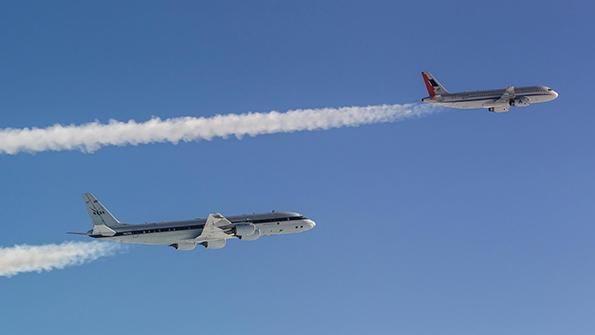
Cleaner-burning sustainable fuels can reduce aircraft contrail cloudiness and their contribution to aviation’s climate impact, joint research by NASA and German aerospace center DLR has concluded.
Burning low-aromatic sustainable aviation fuel (SAF) can result in a 50-70% reduction in soot-particle emissions and the resulting ice crystal concentrations, reducing the warming effect from contrail cirrus clouds, according to research published on May 17 in Nature Communications journal Earth & Environment.
- Sustainable low-aromatic fuels reduce ice crystal concentrations
- After tests of 50% blend, researchers are examining 100% SAF
“We know that contrail formation from jet exhaust has a larger, more immediate impact on climate change than carbon dioxide,” says Richard Moore, a scientist at NASA Langley Research Center and a contributor to the research.
“This evidence is a breakthrough for the possibilities of climate-friendly air transport,” says Christiane Voigt, lead author and head of the cloud physics department at DLR’s Institute of Atmospheric Physics. “A smaller number of ice crystals reduces the energy input into the atmosphere caused by contrails. This significantly reduces the climate-warming effect of contrail cirrus.”
In addition to releasing CO2, aircraft engines emit water vapor and soot particles. In the cold temperatures at cruise altitudes, the water rapidly condenses onto the soot and forms droplets that grow in size as the exhaust plume cools. Eventually, they freeze, forming a visible condensation trail. In certain atmospheric conditions, the contrail can persist for hours, spreading to form contrail cirrus.
Contrail cirrus can alter the Earth’s radiation budget, cooling the atmosphere by scattering solar radiation back into space while also having a warming effect by depositing energy into the atmosphere and trapping outgoing infrared radiation. The net effect on the climate is thought to be warming.
Contrail cirrus yields the largest single contribution to net effective radiative forcing from aviation, the report states, but unlike long-lived CO2, the cloudiness persists for only a few hours. This means reducing contrail cirrus would have an immediate cooling effect on the climate, the researchers say.
Mitigation strategies being studied include weather-dependent flight routing to avoid contrail formation, but this might increase flight times and fuel burn and reduce airspace capacity. The “next best” alternative to avoiding contrail formation is to reduce the impact of the clouds that do form.
“While computer models have shown that contrail ice crystal numbers would vary proportionally with aircraft engine exhaust particle emissions, it’s been really hard to observationally make this link,” Moore says.
“During the joint flight tests conducted by DLR and NASA in 2018, we were able to clearly demonstrate that the use of sustainable fuels gives rise to fewer soot particles in engine exhaust gases, and that this, in turn, results in fewer ice crystals in condensation trails,” Voigt says.
In the 2018 flights, DLR’s Airbus A320 research aircraft flew over Germany using different fuel blends. NASA’s McDonnell Douglas DC-8 research aircraft followed 1-2 min. behind to collect data on the A320’s emissions and contrails.
The flights used conventional Jet A-1 kerosene as the reference fuel and two different SAFs: 70-30 and 50-50 blends of fossil-based Jet A-1 and synthetic paraffinic kerosene produced from plant oil via the HEFA (hydroprocessed esters and fatty acids) pathway.
Jet fuel mainly consists of aliphatic hydrocarbon chains with a smaller fraction, less than 25%, of cyclic aromatic hydrocarbons. Because more energy is required to break the aromatic rings compared with the hydrocarbon chains, they have been identified as major soot precursors.
The fuels tested had different levels of aromatic content, ranging from 18.6% for conventional Jet A-1 down to 9.5% for the 30% SAF blend and 8.5% for the 50% blend. The 50% SAF blend also had a lower percentage of bi-cycle naphthalenes, 0.05%, versus 1.2% for conventional Jet A-1. Naphthalenes are thought to be even more efficient soot precursors than aromatics, the report says.
“Significantly lower soot and apparent ice particle emissions were measured in flight when the A320 burned the alternative fuel blends,” the report says. “Soot emission indices for the HEFA-based SAF blends are 45-53% lower that for the reference Jet A-1 fuel.”
The SAF blends reduced the loss of light, or extinction, caused by contrail cirrus. “Lower ice numbers as measured in the contrails from SAF blends directly translate into reduced contrail extinction, reduced energy deposition in the atmosphere and reduced warming,” the report says.
The DLR-NASA report concludes that targeted use of sustainable low-aromatic fuels should contribute to reducing the regional and global climate impact of aviation. “Our results also highlight the promise of advanced jet fuel design as a method for further reducing the impact.
Following the promising results with the maximum 50% blend that is now allowed, researchers are examining how 100% SAF will affect emissions and contrails. Working with Airbus and Rolls-Royce, DLR’s Dassault Falcon 20E has flown behind an A350 burning 100% SAF. Further flights are planned this fall.


Comments
I am astonished that Aviation Week would not challenge the study, its cost and its totally bizarre conclusions. The only way contrails are reduced is to fly in a warmer dryer atmosphere. That means typically flying lower where fuel consumption is enormous. Even if the scientific assumptions of the study were true which they are not, how could anyone let alone a supposed scientist see the equivalency of a few clean water ice crystals in the sky to the waste of fuel whether sustainable or not. Good lord. We've gone daft!
Arthur Alan Wolk
Thanks for the article - well explained!